The Obligatory
"Play safe. Ski only in clockwise direction. Let's all have fun together."
Monday, June 26, 2006
Twin Peaks Trail
I have learned a lesson.
The lesson is: if you want someone to join you on a hike, don't scare the shit out of them with the statistics of said hike.
I posted a MySpace bulletin about the Twin Peaks trail, warning that it was a pretty long hike in a fairly high elevation. I got a few scattered, eager responses, but when I told them I was leaving L.A. around 6AM on a Sunday, those responders themselves scattered. Still working on that whole "salesmanship" thing.
So after helping Sara out on a shoot for her 48-hour film festival entry, I spent a bit of Saturday night checking straps on the CamelPak and trying to pick out necessary hiking items. Right before I was on my way up to set my alarm and turn in, I got a call from stalwart desert hiking companion Will, who was totally down for a 6:30 call time.
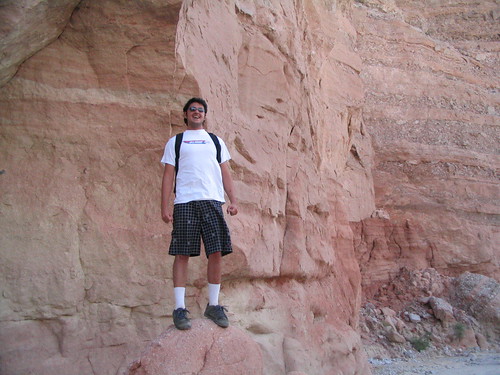
I think Will likes hiking even more than I do.
We hopped on the traffic-free freeways and drove up to La Canada Flintridge, where we picked up some lunches from a local diner and set out on the Angeles Crest Highway.
Just after entering the National Forest land, I had to stop the car to let four deer bound across the road and into some of the brush. Not a bad way to start the day.
We parked the car and started up the Waterman Mountain trail, which, with the absence of snow, was a cinch. For a nice portion of the first trail, our destination was in clear sight:

It's the tall peak on the right hand side, there. There was about five miles of distance and a few thousand feet of elevation change between us.
This was also about when I remembered that I didn't post my National Forest Adventure Pass in my car before we left. I spent a fair amount of time hoping either a). the rangers would be lazy that day or b). getting out of a ticket would be easy.
The trail from Waterman to the Twin Peaks saddle was almost all downhill. Pleasant on the way in, not so much on the way out. But going down, we took time to enjoy the thick cedar smells, surprisingly cool temperatures, and some dry 'rock rivers.' Between swatting at the clouds of (thankfully non-biting) flies that followed us for the entire hike.
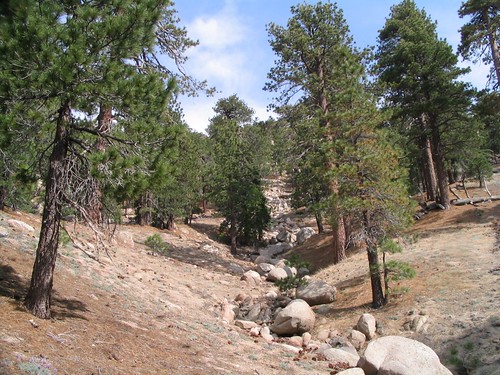
Closer to the Twin Peaks Saddle - the low valley between Waterman and the Twin Peaks - the forest briefly turned into a thicker patch of sycamore, huddled around the one remaining flowing stream. No more snowmelt in July. The forest cleared out almost completely near the actual saddle, leaving behind a few errant examples of nature's weirdness.

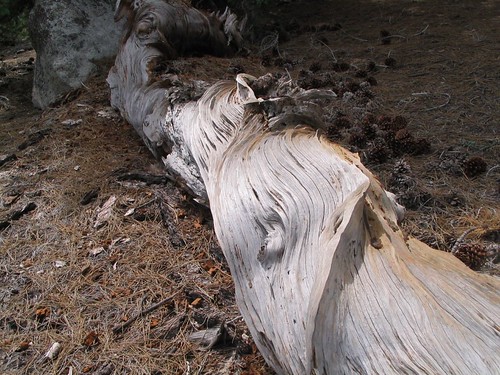
The only other place I've seen fallen trees bleached and bent into shapes like this are on coasts. It's pretty amazing that the wind, sun, and snow 6000 feet above sea level can do just about the same thing, given the time.
Wooden graveyards aside, we stopped for a short break and stared in disbelief at the last section of trail. The path down the Waterman slope had been long and gradual, with plenty of switchbacks. The trail up to the Twin Peaks summit was a straight line from 6550ft to 7761ft, much of it on loose gravel. Needless to say, sections of this part of the trail were done with more hands and knees than feet - both from the steep, slippery incline and the fact that both of us got very out-of-breath from the elevation and exertion.
Eventually we did reach the peak, and after scrambling over a few boulders, we collapsed for a few moments of well-deserved rest. We opened our lunches and ate between panting breaths, taking time to enjoy the hypnotic buzzing of bees through the alpine grasses ... and the view, of course. Each peak practically begging to be climbed.
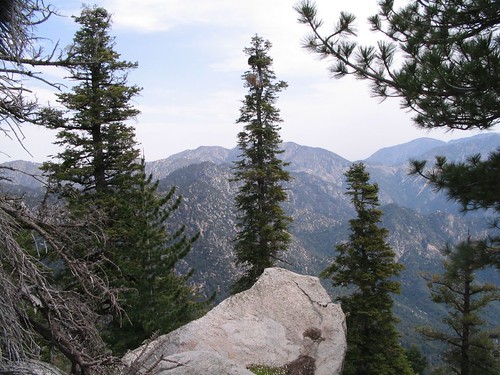
After some lunch and boulder-lounging, we suited back up and slid down the trail to the saddle. The Waterman trail, meandering and easy on the way down, was the complete opposite on the return. This was the most difficult trail I'd attempted in a long time, and the trail took this opportunity to remind me of that. Legs burning and chests pounding, we did our best to keep a steady pace, but had to stop multiple times to rest...
And once to get a picture of a tree that fell and remained almost perfectly still since then, slowly returning to the soil. Gotta stop for Science.
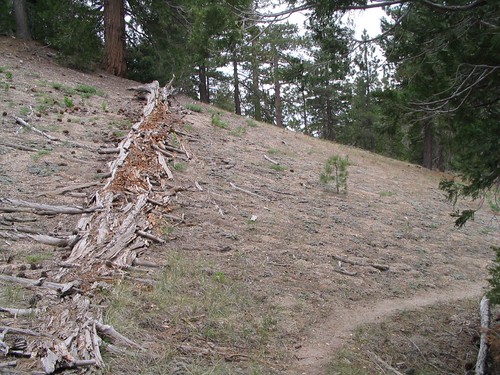
When we finally reached the downhill to the trailhead, our pained waddles turned back to pained hiking. Sitting in the car and taking off our shoes was a much more pleasurable experience than it should have been, but not nearly as much as proving we could cover a long distance with insane elevation changes. I got my sights set on you, Mt. San Antonio...
Oh, and there was a ticket on my car. But it is easy to take care of.
Distance Hiked: 11.43 miles
Footsteps Taken: 22,695
Total Elevation Gain: 3,650 feet, which, for you Office Dwellers, is like taking the stairs up 305 floors.
Percentage of the Rest of Sunday spent on the Couch: 95%
Of course, a few more pics are up at Flickr.
The lesson is: if you want someone to join you on a hike, don't scare the shit out of them with the statistics of said hike.
I posted a MySpace bulletin about the Twin Peaks trail, warning that it was a pretty long hike in a fairly high elevation. I got a few scattered, eager responses, but when I told them I was leaving L.A. around 6AM on a Sunday, those responders themselves scattered. Still working on that whole "salesmanship" thing.
So after helping Sara out on a shoot for her 48-hour film festival entry, I spent a bit of Saturday night checking straps on the CamelPak and trying to pick out necessary hiking items. Right before I was on my way up to set my alarm and turn in, I got a call from stalwart desert hiking companion Will, who was totally down for a 6:30 call time.

I think Will likes hiking even more than I do.
We hopped on the traffic-free freeways and drove up to La Canada Flintridge, where we picked up some lunches from a local diner and set out on the Angeles Crest Highway.
Just after entering the National Forest land, I had to stop the car to let four deer bound across the road and into some of the brush. Not a bad way to start the day.
We parked the car and started up the Waterman Mountain trail, which, with the absence of snow, was a cinch. For a nice portion of the first trail, our destination was in clear sight:

It's the tall peak on the right hand side, there. There was about five miles of distance and a few thousand feet of elevation change between us.
This was also about when I remembered that I didn't post my National Forest Adventure Pass in my car before we left. I spent a fair amount of time hoping either a). the rangers would be lazy that day or b). getting out of a ticket would be easy.
The trail from Waterman to the Twin Peaks saddle was almost all downhill. Pleasant on the way in, not so much on the way out. But going down, we took time to enjoy the thick cedar smells, surprisingly cool temperatures, and some dry 'rock rivers.' Between swatting at the clouds of (thankfully non-biting) flies that followed us for the entire hike.

Closer to the Twin Peaks Saddle - the low valley between Waterman and the Twin Peaks - the forest briefly turned into a thicker patch of sycamore, huddled around the one remaining flowing stream. No more snowmelt in July. The forest cleared out almost completely near the actual saddle, leaving behind a few errant examples of nature's weirdness.


The only other place I've seen fallen trees bleached and bent into shapes like this are on coasts. It's pretty amazing that the wind, sun, and snow 6000 feet above sea level can do just about the same thing, given the time.
Wooden graveyards aside, we stopped for a short break and stared in disbelief at the last section of trail. The path down the Waterman slope had been long and gradual, with plenty of switchbacks. The trail up to the Twin Peaks summit was a straight line from 6550ft to 7761ft, much of it on loose gravel. Needless to say, sections of this part of the trail were done with more hands and knees than feet - both from the steep, slippery incline and the fact that both of us got very out-of-breath from the elevation and exertion.
Eventually we did reach the peak, and after scrambling over a few boulders, we collapsed for a few moments of well-deserved rest. We opened our lunches and ate between panting breaths, taking time to enjoy the hypnotic buzzing of bees through the alpine grasses ... and the view, of course. Each peak practically begging to be climbed.

After some lunch and boulder-lounging, we suited back up and slid down the trail to the saddle. The Waterman trail, meandering and easy on the way down, was the complete opposite on the return. This was the most difficult trail I'd attempted in a long time, and the trail took this opportunity to remind me of that. Legs burning and chests pounding, we did our best to keep a steady pace, but had to stop multiple times to rest...
And once to get a picture of a tree that fell and remained almost perfectly still since then, slowly returning to the soil. Gotta stop for Science.

When we finally reached the downhill to the trailhead, our pained waddles turned back to pained hiking. Sitting in the car and taking off our shoes was a much more pleasurable experience than it should have been, but not nearly as much as proving we could cover a long distance with insane elevation changes. I got my sights set on you, Mt. San Antonio...
Oh, and there was a ticket on my car. But it is easy to take care of.
Distance Hiked: 11.43 miles
Footsteps Taken: 22,695
Total Elevation Gain: 3,650 feet, which, for you Office Dwellers, is like taking the stairs up 305 floors.
Percentage of the Rest of Sunday spent on the Couch: 95%
Of course, a few more pics are up at Flickr.
Labels: hiking
7 Comments:
I'm not familiar with wild animals in that part of your country so it's been bothering me, enough to ask, are there not any animals in these mountains that you should be worried about?
And if there are animals you should be worried about, are you actually prepared to run into them?
Just wondering...
And if there are animals you should be worried about, are you actually prepared to run into them?
Just wondering...
Most of the mountains in Southern California are home to mountain lions, and some of them to bears as well. They are rare and even less likely to be active during the day.
I know what I'm supposed to do if I run into one of 'em, but thankfully haven't had to test that knowledge in person.
I know what I'm supposed to do if I run into one of 'em, but thankfully haven't had to test that knowledge in person.
When I was hiking in the Panamints I was warned of mountain lions. When I asked what I should do if I encounter one, I was told "carry a pistol."
Hmm.
Hmm.
, at 1:54 PM
Jeeze, if my mom reads this, she's not gonna let me hike anymore!
Yeah, there are dangerous animals up in the mountains, but the way I look at it is this: When are you doing something that can't potentially kill you?
I drive on some of the country's most congested highways in a city filled with the country's worst drivers. In California, you're 300 times more likely to get killed by a dog than a mountain lion, and 2000 times more likely to get killed by a car.
I appreciate the concern, though : )
Yeah, there are dangerous animals up in the mountains, but the way I look at it is this: When are you doing something that can't potentially kill you?
I drive on some of the country's most congested highways in a city filled with the country's worst drivers. In California, you're 300 times more likely to get killed by a dog than a mountain lion, and 2000 times more likely to get killed by a car.
I appreciate the concern, though : )
In California, you're 300 times more likely to get killed by a dog than a mountain lion, and 2000 times more likely to get killed by a car.
A dog? What's a dog going to do to you?
When I asked what I should do if I encounter one, I was told "carry a pistol."
so do you carry a pistol?
and one more..When are you doing something that can't potentially kill you?
I guess that's a good philosophy to carry around. I've been sitting here trying to think of things you can do that wouldn't kill you and I can't really come up with anything that's not arguable. ...
A dog? What's a dog going to do to you?
When I asked what I should do if I encounter one, I was told "carry a pistol."
so do you carry a pistol?
and one more..When are you doing something that can't potentially kill you?
I guess that's a good philosophy to carry around. I've been sitting here trying to think of things you can do that wouldn't kill you and I can't really come up with anything that's not arguable. ...
Naw, I don't carry a gun. Can't stand the things.
Instead, I used some common sense and read a book. Lions prefer to avoid people. So, unfortunately, when you do happen to stumble upon a mountain lion, it can get ugly, as it usually means the lion is either sick (and unpredictable) or it didn't run away because it has cubs nearby. Either way, if it feels threatened or desperate, it could get ugly.
So, in those situations, the book says to make yourself appear as large as possible (spread your arms, stand up straight, lift your coat above your head, etc), talk to it in a firm, deep voice (but don't yell), and finally slowly back away, but if charged or chased, do not run. Stand your ground and be prepared to fight. The book recommends throwing sticks and rocks if charged, but as a last resort says to -- get this -- be ready to throw some punches and try to wrestle!
Hmm. Wrestle a lion. You know, maybe I will carry that gun afterall?
As for bears, that's a different story. Research is actually showing that grizzlies are becoming more and more aggressive. No longer does curling into a ball and playing dead seem to work. Grizzlies in Alaska will usually, well... just eat you if you curl up.
I've read everything from doing the same as with a mountain lion, to running like hell, to just making sure to carry bear spray (and then running like hell). Frankly, I think I'd choose the piss my pants and hope they don't like amonia route.
That said, although I've never seen a grizzly, I have had numerous encounters with black bears. Most of the time they sat there looking at me quizzically, and I just walked on past them. Once, the bear had cubs in tow, and I just turned around and walked the other way. If I ever see bear tracks or just start to feel uneasy, I'll usually start whistling while I hike, or jiggle my keys. The sound is usually enough to give any critter ahead a heads up to get out of my way.
There are bigger things to worry about on a hike than the wildlife. I'm more concerned about breaking my leg, or running out of water than becoming a tasty snack.
Instead, I used some common sense and read a book. Lions prefer to avoid people. So, unfortunately, when you do happen to stumble upon a mountain lion, it can get ugly, as it usually means the lion is either sick (and unpredictable) or it didn't run away because it has cubs nearby. Either way, if it feels threatened or desperate, it could get ugly.
So, in those situations, the book says to make yourself appear as large as possible (spread your arms, stand up straight, lift your coat above your head, etc), talk to it in a firm, deep voice (but don't yell), and finally slowly back away, but if charged or chased, do not run. Stand your ground and be prepared to fight. The book recommends throwing sticks and rocks if charged, but as a last resort says to -- get this -- be ready to throw some punches and try to wrestle!
Hmm. Wrestle a lion. You know, maybe I will carry that gun afterall?
As for bears, that's a different story. Research is actually showing that grizzlies are becoming more and more aggressive. No longer does curling into a ball and playing dead seem to work. Grizzlies in Alaska will usually, well... just eat you if you curl up.
I've read everything from doing the same as with a mountain lion, to running like hell, to just making sure to carry bear spray (and then running like hell). Frankly, I think I'd choose the piss my pants and hope they don't like amonia route.
That said, although I've never seen a grizzly, I have had numerous encounters with black bears. Most of the time they sat there looking at me quizzically, and I just walked on past them. Once, the bear had cubs in tow, and I just turned around and walked the other way. If I ever see bear tracks or just start to feel uneasy, I'll usually start whistling while I hike, or jiggle my keys. The sound is usually enough to give any critter ahead a heads up to get out of my way.
There are bigger things to worry about on a hike than the wildlife. I'm more concerned about breaking my leg, or running out of water than becoming a tasty snack.
, at 11:05 AM
So educational this topic has become.
What exactly is bear spray? I'm assuming it's something like bug spray but how exactly is a little spray going to repel a friggin bear?
Frankly, I think I'd choose the piss my pants and hope they don't like amonia route.
That's probably what I would do too.
I guess you guys wouldn't be doing what you do if you were worried about becoming snacks.
So thanks for all the information. I'll try to remember all of this if I ever find myself in on a hike in Southern California.
What exactly is bear spray? I'm assuming it's something like bug spray but how exactly is a little spray going to repel a friggin bear?
Frankly, I think I'd choose the piss my pants and hope they don't like amonia route.
That's probably what I would do too.
I guess you guys wouldn't be doing what you do if you were worried about becoming snacks.
So thanks for all the information. I'll try to remember all of this if I ever find myself in on a hike in Southern California.
















